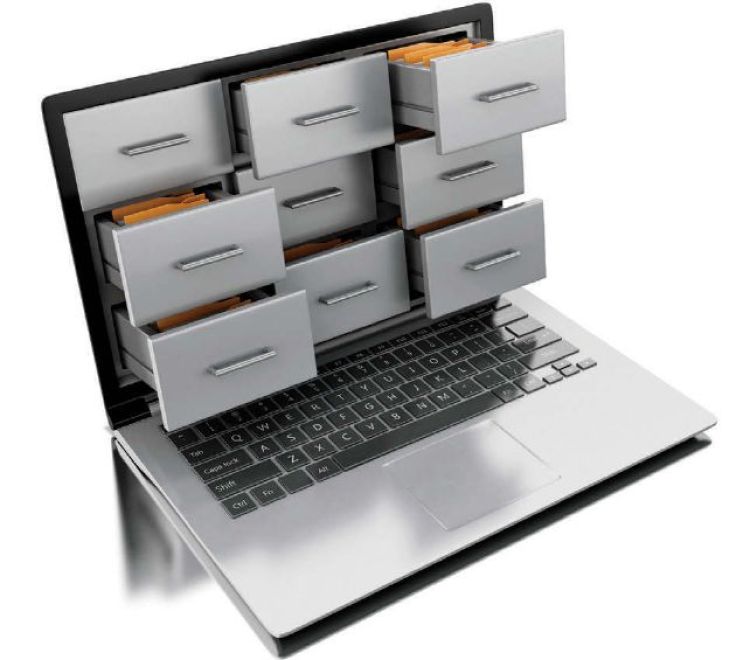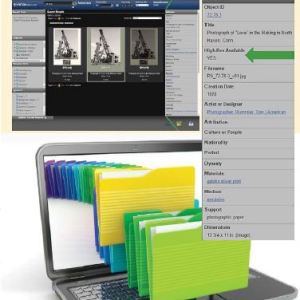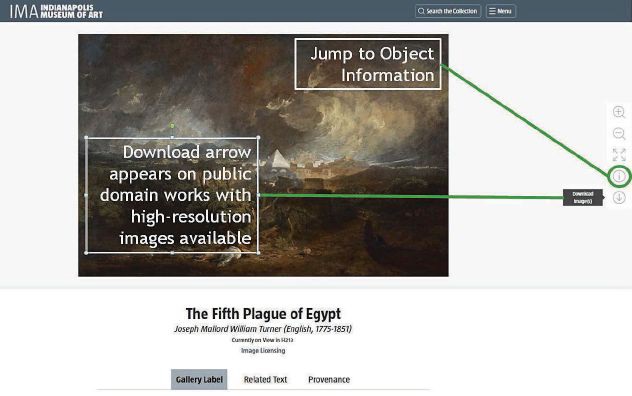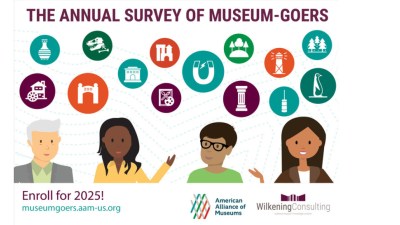
This article originally appeared in the September/October 2017 issue of Museum magazine.
How the Indianapolis Museum of Art implemented digital asset management and document management systems.
As the stalwart guardians of collection data and all related information, registrars and collections managers have long prided themselves on retention—of everything. In the not-so-distant past, the height of collection data retention was physical storage. File cabinets, archival boxes, and compact storage units full of materials documenting years of object histories, acquisitions, loans, exhibitions, etc.—every aspect of a collection’s management was physically printed and retained. Today, this is only part of the equation. While registrars’ offices still and likely always will maintain physical files about collection objects, there is an equal amount of data to be retained electronically, reducing the need to print and retain hard copies of everything.
In 2013, the Indianapolis Museum of Art (IMA) began the process of identifying a new digital asset management system (DAMS) to manage its image files and more broadly share rights information related to its works. We also looked at a new document management (DM) tool to organize the vast number of files related to the collection and institution. None of the systems we had at that time—two DAMS and a DM—were serving our needs.
Here are tips to consider as you plan to upgrade your systems.
Determining Your System Needs
The systems I’m going to describe are a collections management system (CMS), a digital asset management system (DAMS), and a document management tool (DM).
While a museum’s physical and technological systems are inherently informed by its collection size and scope, there are many software tools to help with collections management. Chief among these is a database. At its simplest, the database may reside in Microsoft Excel or Access. For small collections or collections largely supported with the help of volunteers, these options may be the most accessible in terms of both cost and end-user knowledge. As collections become more complex, necessitating more data management, adopting a CMS becomes almost requisite. According to the book Rights & Reproductions: The Handbook for Cultural Institutions, (co-published in 2015 by IMA and AAM) a CMS is a “computer program that facilitates the administrative responsibilities (cataloging, accessioning, tracking loans, exhibition planning, digital image retrieval, copyright management, etc.) associated with the documentation and stewardship of a cultural institution’s holdings.” While a CMS’s primary duty is to retain data, the ability to export and analyze the data based on various research queries should not be underestimated when assessing possible systems. Additionally, the ability to synchronize with other systems used by the museum is a paramount consideration.

 While a CMS may function as the sole repository for collection data and media (image, video, or audio files), larger institutions and those with high volumes of content may need to adopt a DAMS. Rights & Reproductions describes a DAMS as a “digital program used for storing, managing, and retrieving digital assets, such as images of collection
While a CMS may function as the sole repository for collection data and media (image, video, or audio files), larger institutions and those with high volumes of content may need to adopt a DAMS. Rights & Reproductions describes a DAMS as a “digital program used for storing, managing, and retrieving digital assets, such as images of collection
objects.” Working in conjunction with a CMS, a DAMS allows an institution to efficiently utilize and disseminate media while retaining collection information within the media’s metadata—a principal concern today given the vast numbers of digital files in existence. (Metadata describes structural data and descriptive data. An example of structural data is the type of file or size of file. An example of descriptive data is the subject matter. Metadata allows data to be sorted and filtered, searched and discovered in an easier manner.) Separating metadata from media files could lead to misattributions of artists, collections, donors, and owners.
Another system that a museum may consider adopting is document management (DM), a tool to organize the vast number of files related to the collection and institution. Functioning through the same software as the DAMS or a completely separate program, some DM tools may also have the capability to archive digital documents and e-mail communications for long-term retention as part of a larger electronic records management program. When combined with an institution’s CMS and DAMS, a DM system can increase discovery and search capabilities.
Working Together—Systems and Staff
Our existing DAMS and DM systems were selected in 2011 by the technology department with limited input from the departments that would be the end-users. This resulted in a choice of software that tried to be both a DAMS and a DM without doing either effectively. Not surprisingly, staff adoption was minimal. In addition, there were numerous problems as we implemented the DAMS, including the discovery that it would not support digital negative (DNG) files—the best file format for archival purposes. More devastating was the finding that the DAMS would only support 1,000 files per folder, resulting in numerous files being lost or corrupted during the migration from the old DAMS. The DM side was equally ineffective; it did not provide intuitive keyword searches, and the documents did not undergo any optical character recognition (OCR) indexing when ingested (migrated). Problematic on both sides of this system was the lack of thumbnail previews for the images, which meant that each file had to be downloaded and opened to ensure the correct item was selected.
To avoid a repeat of this situation, we made the strategic decision to separate the evaluation and implementation of the DAMS and DM. Two interdepartmental task forces were formed to research and purchase our new system or systems: the core DAMS Task Force began work in 2013 and the DM Task Force began work in 2015. Both included vested partners across divisions, as well as larger test groups from each department. Bringing representatives from each department into the process of evaluating and selecting the new software—based on the recommendations of the core task force—has led to a more complete implementation and greater adoption of the systems by the daily end-users.
Selecting a New DAMS
Before proceeding, the DAMS Task Force needed to identify desired functions for the new system, learn why the previous DAMS were not the right fit, and why their integration and adoption failed. Over the course of several months, the team:
- created a list of DAMS requirements
- created an internship for an information science graduate student to research various DAMS options as well as what other institutions were using
- analyzed the pros and cons of an open-source system (computer software that is widely available without restriction in source code form) versus a commercial system
- interviewed staff at other museums to learn about their experiences The DAMS Task Force then made recommendations to senior staff. With unanimous approval, senior staff and the test group selected a system called Piction. Piction’s staff was in the position to move quickly; however, IMA made a conscious decision to slow the ingestion and implementation process down to 18 months, recognizing that the museum would get out of the DAMS what was put into it.
Developing a Staged Timeline
We have numerous image and media collections, and it was not viable to migrate them all simultaneously. We developed a staged timeline over the 18-month initial integration for which images would be migrated immediately and which would wait. Priority was placed on the collection images as the first to be ingested, with non-collection images (event, exhibition, and institutional spaces: gardens and historic properties) as the second content set for ingestion. Image sets continue to be added, many of which previously were accessible only to the departments that created them. The archives department ingested images beginning in 2015, and the conservation department began adding images in late 2016. The ingestion of each of these image groups required development of unique metadata schemas to reflect the types of media files and recorded information within each. Even today, the ingestion of content is an ongoing process as more collection works are digitized, events photographed, and new image sets, like horticulture, are prepared for addition to the DAMS.
Organizing the Images
Before we could begin the migration to the new DAMS, it was essential that we organized and approved the collection images. This monumental task, undertaken by photography staff, included hiring a six-month temporary position and evaluating over 90,000 image files for quality, color balance, and contrast levels. Every file was renamed according to new naming conventions, and a primary image was selected for each collection piece.
New file naming conventions for each photo looked like this: department prefix_accession number_ version number. For example, PS_47-4_v01 indicates the file was created by the photography studio (PS) and REG_47-4_v01 was created by the registration department (REG).
We then created three versions of each approved file: a DNG for archival purposes, a high-resolution TIFF for publications (or other high-end reproductions), and a JPEG with the color bar cropped out for use in digital presentations, on the web, or for research purposes. (Figure 1)
Simultaneously, we completed a mapping of our CMS fields to determine which fields we would push into the DAMS to pair with collection images. Knowing that additional fields could be added in the future from the CMS to the DAMS, the task force decided to begin with only the fields required to generate a full caption and credit line. In our previous DAMS, the CMS was completely separated from the image files, which meant they lacked important object information that could otherwise be retained in the metadata. The ability to add more CMS fields into Piction has proven to be very useful as more image sets are added that require different information, such as the integration of conservation images.
Once that process was underway, we turned our attention to our hundreds of thousands of non-collection image files. The DAMS Task Force created an IMA-approved vocabulary, modeled after a stock photography site like Getty Images. The photography staff’s process changed to include these descriptors and keywords, which are used to search the files in Piction. A star rating system is utilized within Piction to alert end-users of the primary or “best” images from a given series of images. The keywords and star ratings enable staff to be self-sufficient, reviewing the images without going through the photography department for every image request.
Assessing and Adopting a New DM
Modeled after the success of the DAMS Task Force, in 2015 the DM Task Force undertook a similar process to assess and integrate a new system. An exhaustive list of DM needs was created with two tiers—twenty-five required functions and an additional twenty-five desired, but not required, applications. After analyzing DM-only systems as well as those integrated as part of a larger DAMS, the decision was made to acquire and implement the DM side of Piction.
During the first year of the DM implementation, the task force initially reviewed and created a controlled vocabulary to improve keyword searches, developed file naming conventions, and organized files for ingestion. Then, the team outlined the DM’s overall organization. Four top levels—archives, departments, institutional repository, and projects—would contain numerous subcategories, including a location to store project documents that all involved staff can access. DM continues to be refined as more files are added and the task force works with Piction this year to implement plug-ins for Microsoft Office. The plug-ins will allow us to directly access documents from Piction and save new versions back into the DM directly from the native application.
Beyond Collections Staff: Access and Self-Sufficiency
While the files were being integrated on both the DAMS and DM sides of Piction, the permission levels for staff were assigned. Some staff have access to everything; some to only parts. For instance, for the DAMS, the majority of staff have permissions that limit their view to only the JPEG files. Select staff members can access the TIFF files. A final administrative group has access to view not only the JPEG and TIFF versions, but also the original DNG files. Since most staff have limited access, we added a custom metadata field with collection images that alerts users if a high-resolution TIFF exists, which enables them to submit the appropriate request form: either for access to the TIFF or to request new photography of the object. (Figure 2) For the DM, permissions were assigned based on retention of the documents. The archives and institutional repository categories are limited to read-only status for all staff, while documents within the projects and departments are available for downloading and editing based on the department and project(s) to which each staff member belongs.
The permission levels have made staff more self-sufficient in accessing data, documents, and media about IMA’s collections and the institution itself, and have led to less demand on the photography, archive, and registration staff. Collections staff now have more time to document the collection and research in-depth questions. The increased access to collection data also enabled us to relaunch our online collection pages in 2015, with improved search functionality and image quality; more object data, including provenance histories; and direct downloads of high-resolution image files of public domain works under open access. (Figure 3)
Lessons Learned
While there are many CMS, DAMS, and DM options, it is important for museums to assess open-source options as well as commercially available products. With pros and cons for both, institutions must consider not only their budget for system acquisition but also their long-term ability to maintain and support the software. Having outside vendor support can be an important feature for museums that don’t have systems experts on staff.
The biggest lesson we learned through the DAMS and DM task force processes, is that you are never really “done.” Rather, slowing ingestion and implementation processes down can lead to more ingested content, greater end-user adoption and continued opportunities to integrate and refine the metadata organization and search capabilities in the systems. As we have added more image sets into Piction and integrated their DM module, we have had to add metadata and reconsider functions of request baskets and advanced search options to better reflect the growing content. To ensure we are continuing to get the best out of our instance of Piction, we have merged the two task forces into a standing committee to oversee digital collections: the Digital Media and Data Management Advisory Committee. Made up of former members of both task forces as well as some additional staff members, this advisory committee will continue to oversee the addition of more content into Piction and its long-term archiving.
Choosing the right CMS, DAMS, or DM and integrating them with one another as well as with other existing systems can be daunting. But with the right internal planning, museums can develop a streamlined process for the long-term preservation of and access to our digital media collections. At the end of the day, integration of these systems solves the need to find an ecient way to organize, utilize, retain, and disseminate collection data and media.
Anne M. Young has led the rights and reproductions department at the Indianapolis Museum of Art since 2010. Previously, she was photographic archivist for the Kinsey Institute at Indiana University and worked for the Art Gallery of Ontario and George Eastman Museum. Young is the current co-chair of the Rights and Reproductions Professional Practices Committee of AAM’s Collections Stewardship Professional Network and the editor of the 2015 publication Rights & Reproductions: The Handbook for Cultural Institutions, which is available in electronic format at aam-us.org/
ProductCatalog/Product?ID=5186.










Comments